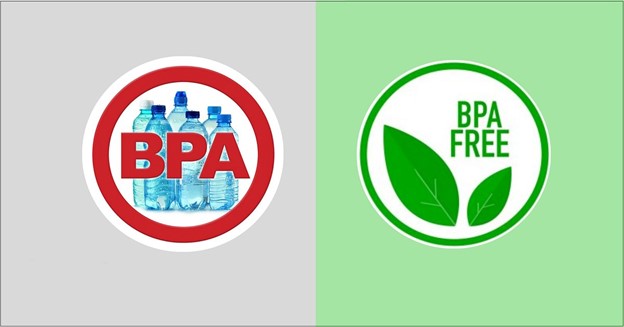BPA is an industrial chemical that can contaminate food and beverages. Some experts say BPA is toxic and people should make an effort to stay away from it. But perhaps you still wonder if it's really that dangerous? This article will tssilicone.com provide detailed information about BPA and its health effects.
1. What is BPA ?
BPA, abbreviated Bisphenol A (chemical formula (CH3)2C(C6H4OH)2), is a chemical found by a Russian scientist in the 1891s and by the 1950s, it was used to harden plastics and rubber.
BPA is mainly used in the production of polycarbonate (PC plastic) and epoxy resin, among many other plastics and rubber. Their actual products such as water bottles, sports equipment, CDs and DVDs, water pipes, and even poor quality toys for young children...
Today, BPA-containing plastics and rubbers are commonly used to create food containers, baby feeding bottles, and other products. BPA is also used to create epoxy resin, which is applied to the inner layers of food containers to keep the metal from corroding and breaking.
2. What products contain BPA?
Common products that may contain BPA include:
• Items are packaged in plastic.
• Canned food.
• Toiletries.
• Feminine hygiene products.
• Thermal receipt printing paper.
• CDs and DVDs.
• Consumer electronics.
•Glasses.
• Sports equipment.
• Fillings.
It is worth noting that many labeled products do not contain BPA because merely the manufacturing company has replaced the substance with BPS (bisphenol-S) and BPF (bisphenol-F).
But even small concentrations of BPS and BPS can jeopardize the function of cells similar to BPA. Therefore, choosing BPA-free plastic bottles is not a right solution.
Plastic products labeled recycling 3 through 7 or with the word "PC" almost all contain BPA, BPS, or BPF.
When buying plastic or rubber products, check the plastic symbol and avoid the above 3 types. They are usually denoted by manufacturers with specified numbers placed in a 3-arrow triangle at the bottom of the product.
3. How does BPA enter your body?
The main source of exposure to BPA is eating.
Not all BPA counts are firmly linked when containers are produced. This allows some of the BPA to escape to the surface and come into contact with the item inside the container, and especially when exposed to catalysis such as temperature or foods with swordtails and acids, the amount of BPA released is even greater.
BPA from bottled water

For example, a recent study recruited several volunteers, and found that BPA levels in the urine decreased by 66% after 3 days when participants avoided packaged foods.
In another study, participants were given fresh food or canned soup daily for 5 days. The amount of BPA identified in the urine of those who consumed canned soup was 1,221% higher than those who ate fresh food.
In addition, the World Health Organization reports that BPA levels in babies breastfed are up to 8 times lower than those fed BPA bottles.
4. Does BPA have adverse health effects ?
Many experts say BPA is harmful - but others disagree.
The section below explains what BPA does inside the body and why it is still controversial.
4.1 Biomechanics of BPA
BPA is thought to mimic the structure and function of the hormone estrogen.
Because it resembles estrogen, BPA can bind to estrogen receptors and affect the body's processes, such as growth, cell repair, fetal development, energy activity, and reproduction.
Furthermore, BPA can bind to other hormone receptors, such as altering the function of thyroid receptors.
Our bodies are very sensitive to changes in hormone levels, which is why BPA's ability to mimic estrogen is believed to affect the body.
4.2 BPA controversy.
As the information given above, many people wonder why BPA should be banned.
The use of this type of substance has been restricted in the EU, Canada, China and Malaysia – especially products intended for babies and young children.
Several U.S. subcommittees have applied laws to this type of chemical, but no federal regulations have yet been established.
In 2014, the U.S. Food and Drug Administration (FDA) issued its latest report, which confirmed the official 1980s daily exposure limit of 50 micrograms of BPA per kilogram and concluded that BPA does not affect when it is allowed.
However, rodent studies show that the negative effects of BPA appear to be much lower at permissible levels.
What's more, research in monkeys shows that levels of BPA at levels comparable to humans affect their reproduction.
A survey revealed that studies funded by industrial companies did not show any bpa scandal. Meanwhile, 92% of unfunded studies from industrial companies found incredible negative effects of BPA.
4.3 BPA can cause infertility in both men and women
BPA can affect many aspects of fertility.
One study observed that women who frequently miscarry 3 times more often had BPA levels in their blood than women who had successful pregnancies.
More over, studies in women who are conducting assisted reproductive methods also show that high levels of BPA cause these women to have less egg production and their ability to carry out pregnancy decreases by up to 2 times.
Among couples undergoing in vitro fertilization (IVF), couples where the husband had high levels of BPA, their embryos were 30 to 46 percent lower-quality.
A separate study found that men with BPA levels 3 to 4 times higher than normal had low sperm concentrations and counts.
In addition, men who work at BPA companies in China claim that erections are up to 4.5 times harder for them and that sexual satisfaction is reduced compared to other men.

4.4 Negative effects on young children.
Most studies (not all) have found that young children whose mothers were exposed to BPA at work weighed 0.2 kg less at birth than those whose mothers were not exposed to the substance.
Babies born to parents exposed to BPA also have shorter distances from the anus to the genitalia, which indicates that hormones are affected during fetal development.
What's more, babies born to mothers with higher BPA levels tend to be more prone to hyperactivity, anxiety, and depression. These children also showed 1.5 times greater emotional response and 1.1 times more aggressiveness.
Finally, exposure to BPA in early life is also thought to increase the likelihood of prostate and breast tissue cancers.
However, although many animal studies support that the effects of BPA on humans are very negative, studies in humans are less conclusive.

4.5 Associated with heart disease and type 2 diabetes mellitus.
Human studies show a 27 to 135 percent greater risk of high blood pressure in people with high BPA levels.
What's more, a survey of 1,455 Americans linked to BPA had an 18 to 63 percent higher risk of heart disease and a 21 to 60 percent higher risk of diabetes.
In another study, high BPA levels were associated with a 68 to 130 percent higher risk of developing type 2 diabetes.
People with high BPA levels often have up to a 37% higher risk of insulin resistance, the main cause of metabolic syndrome and type 2 diabetes.
However, there are several studies that show no link between BPA and these conditions.

4.6 May increase the risk of obesity.
Obese women typically have 47% higher BPA levels than normal-weight women.
Several studies have also reported that people with high BPA levels are 50 to 85 percent more likely to be obese and 59 percent more likely to have a larger-than-normal waistline — though not all studies have agreed with this finding. Similar signs are noticed in children and adolescents.
Although prenatal exposure is associated with increased weight in animals. This has not really been confirmed in humans.

4.7 May cause other health problems.
BPA exposure has also been linked to a number of health problems:
Polycystic Ovary Syndrome (PCOS): BPA levels were 46% higher in women with pluripotent ovarian disease when compared to women without it.
- Preterm birth: Women with higher-than-normal levels of BPA are 91% more likely to have a baby before 37 weeks.
- Asthma: prenatal exposure to BPA is associated with a 130% higher risk of wheezing in infants younger than 6 months. Being exposed to BPA as a child will cause wheezing to last until later.
- Liver function: High BPA levels are associated with a 29% increased risk of abnormal liver enzymes.
- Immune function: High levels of BPA also contribute to a weakened immune system.
- Thyroid function: High BPA levels are also associated with thyroid hormone abnormalities, indicating that thyroid function is impaired.
- Brain function: African green monkeys after being exposed to BPA (which has been evaluated for safety by the U.S. Environmental Protection Agency) showed a loss of connectivity between brain cells.

4.8 How to reduce exposure to BPA.
With all the negative effects that this type of substance has. You'll probably want to stay away from BPA. Although removing BPA is difficult, there are several ways for them to minimize exposure to this type of chemical:
4.8.1. Use BPA free plastic.
BPA Free simply does not contain BPA that is dangerous to health. Plastic products with BPA free notes and certified by the authorities are safe products for human use, especially when they come into direct contact with food.

4.8.2 Use products with safe materials.
• Avoid eating packaged foods: Eat mostly fresh, whole foods. Limit the use of canned foods and foods packaged in plastic packaging with recycling labels 3 to 7 or with the letters "PC".
• Drink water from containers made of glass: Buy water sold in glass bottles instead of plastic or cans, and use small glass glasses instead of plastic ones.
• Stay away from BPA-containing products: Limit your exposure to receipts as much as possible because they contain a lot of BPA.
• Be sure that the toys you buy for your child are made from BPA-free materials -- especially those that young children can chew on or suck with their mouths.
• Don't microwave plastic containers: Reheat and stock up on food with containers made from glass.
• Buy infant formula

In the clear evidence of BPA toxicity, it is important to gradually limit exposure to BPA and other food toxins. In particular, it is beneficial for pregnant women to avoid exposure to BPA -- especially in the early stages of pregnancy. We absolutely don't need to worry about occasionally drinking water from plastic bottles made from BPA or eating canned food.
However, ditching plastic containers and instead using BPA-free ones requires little effort but can achieve huge health benefits.
If you aim to eat fresh, pure foods, you will automatically limit your exposure to BPA.

Through the article, you have learned somewhat about the dangers and incalculable harms of BPA. Topsheng Silicone is a company with a solid foundation and extensive experience in manufacturing silicone products (to know what silicone is), especially producing quality and medically tested silicone products, completely BPA-free, we can adjust color or shape according to your requirements
Topsheng Silicone specializes in manufacturing silicone products and parts in large quantities, with extensive experience and production technologies such as extrusion, molding, injection molding. With high technology and workmanship, we can also produce all kinds of silicone products according to customers' requirements, we are confident to meet all your requirements even the most difficult, with the motto is "As long as you have an idea, We're going to make it happen."
Contact us now for more information and to formulate and immediately implement your idea:
Phone Numbers 0867571038.
Gmail: sales@tssilicone.com
Web: tssilicone.com.
Address: 210 Tân Thới Nhì 1, Tân Thới Nhì, Hóc Môn, TP HCM.
BPA. Carcinogenic factor